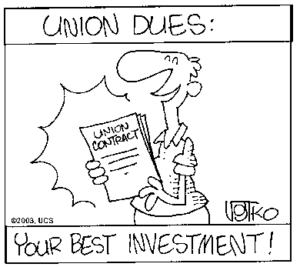 By GREGORY N. HEIRES
By GREGORY N. HEIRES
Union-busting law firms and right-wing groups charge that unions are fleecing members through mandatory dues charges.
What’s worse, they say, workers get little back for their contributions.
“Union Dues Are A Prohibitively Bad Investment” blared the headline of an op-ed article in Forbes magazine by conservative lobbyist and consultant Richard Berman.
“In the free market, of course, we can fire our financial adviser if they lose our money or spend it in ways we don’t approve,” Berman says. “Unfortunately for union members, it doesn’t work the same way when their union is letting them down.”
But the argument that union dues are a rip-off and bad investment doesn’t add up. Furthermore, this attack is usually linked to the bogus charge that so-called anti-democratic unions funnel dues into political activities against the wishes of their members.
Far from being a bad “investment,” dues are arguably the best expenditure workers can make to protect their jobs and livelihoods.
In Illinois, for every $1 a worker pays in dues and fees, she receives an estimated $6.12 back in after-tax income, according a recent study by Frank Manzo IV, policy director of the Illinois Economic Policy Institute, and Robert Bruno, director of the Labor Education Program of the School of Labor and Employment Relations at the University of Illinois at Urbana-Champaign. The financial return on dues is in addition to health-care and other benefits that come from union membership.
The annual return on investment for the average worker in Illinois amounts to 512 percent. (The average annual return on the S&P 500 since its inception in 1928 through 2014 was about 10 percent, according to Investopedia.)
The authors based their study on 2014 LM-2 reports unions are required to file with the Dept. of Labor, as well as data from the U.S. Census Bureau and the Bureau of Labor Statistics. The study covers 258 labor unions that represent 744,439 members in Illinois, where 15.2 percent of the workforce is organized.
The typical union member in Illinois contributes $663 in annual dues, fees and other membership payments to her union local. That comes to $55 a month. Union membership boosts the annual after-tax income of workers by $4,060 a year.
Conservatives ignore the positive ripple effect unions have on the economy.
The higher earnings and consumer spending of union families creates 43,000 jobs in Illinois. This includes 10,000 jobs in labor unions and about 33,000 in the rest of the economy.
All told, union members add $3.6 billion to the state’s economy. They generate $218 million in tax revenue.
“Any attempt to weaken labor organizations in Illinois, if successful, would reduce these positive impacts that union members have on the state,” the authors say.
The report debunks the argument of conservatives like Berman that unions use a large percentage of dues for political activity. As executive director of the Center for Union Facts, Berman is promoting the Republican-backed Employee Rights Act, which would roll back decades labor protections and undermine the power of unions.
In Illinois, labor unions spend 77 percent of dues and fees on bargaining and representation. Only 2 percent of dues and fees–$14 a year for each member–are spent on political activity. Unions account for 10 percent, or $30.7 million, of the state and local political spending in Illinois.
Basically, conservatives paint a picture in which unions enjoy a giant piggy bank of funds that allow unaccountable labor leaders to politicians. In fact, many unions make state and local political expenditures after a democratic screening process that includes and a vote by elected rank-and-file representatives. In addition, members have the legal right to request a return of their dues spent on politics.
In general, using dues for federal elections is prohibited. But dues can be used to educate and communicate with the membership about politics. Dues can also be used for non-partisan get-out-the-vote work and voter registration. And members may contribute to union PACs for expenditures in national elections.
A companion study by the Midwest Economic Policy Institute describes the impact of construction union dues in Minnesota. This report estimates for every $1 paid in dues and fees, union members receive $5.59. The annual cost of union dues and fees results in an increase in wages of $7,720 after taxes.
In 2014, unionized construction workers contributed $808.6 million and 9,300 jobs to Minnesota’s economy. They added $99.5 million more to the state’s revenue than there would have been without unions.
The attack on dues is simply part of the right-wing arsenal being used to try to wipe out unions. It was behind anti-union Friedrichs v. California Teachers Association case before the U.S. Supreme Court that resulted in a deadlock earlier this year.
In the early ‘90s two labor economists found that labor unions raise the wages of workers by 10 to 17 percent. This “union wage premium”—a result of the financial investment of members in their union–continues to this day. And it is what anti-union interests would like to destroy–along with the political power of unions.

